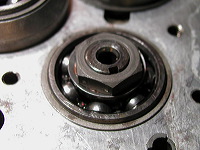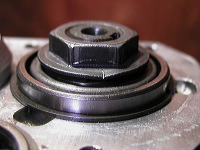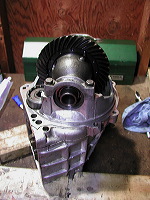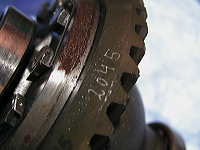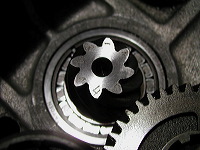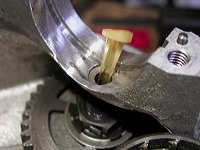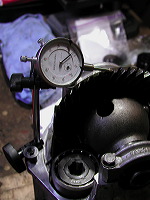|
|
Here are the input shaft nut and washer, installed per Jack Lawrence's recommendation. In addition to the cleaning and anti-seize tips, Jack L. also recommends tightening these nuts to a value at least 50% higher than in the Saab shop manual. In fact, he said, experience has taught modern transaxle technicians do almost everything somewhat differently from what the Saab manual specifies. |
|
|
Here's the pinion shaft nut, installed and locked in place. Note the small chisel tap on the edge of the nut's shoulder, locking it into the notch on the washer.
An advantage of this locking system is that if you need to redo the job in the future, you probably can carefully tap out the notch and use the nut again. |
|
|
With the nuts torqued and locked down, it's time to upend the transaxle and work on the ring-and-pinion end. After unbolting two bearing caps (one visible toward camera) I can lift out the ring gear and differential. |
|
|
For quiet operation, the spacing between the ring gear and the pinion gear needs to be adjusted to the correct value. Here's the ring gear, complete with factory-hand-scratched ID mark.
(Yes, that's a rust spot above it -- it probably developed during the previous owner's storage of the transaxle. With one section of the ring gear always above the level of gear oil in the box, there was nothing to protect it from rusting. That's a good reminder to me to turn the shaft occasionally, to keep the lubricant distributed along the gears.) |
|
|
Here's the pinion gear, complete with its own hand-scratched number for matching to the ring gear. |
|
|
The critical spacing between the ring gear and the pinion gear is adjusted by moving the ring gear back and forth between the two bearing caps (seen in an earlier picture.) You adjust this spacing by moving ring-shaped shims from one side to the other.
Removing shims from behind one bearing and putting them behind the other keeps the total space constant, but moves the ring gear back and forth in tiny increments to get the right spacing. |
|
|
While I'm in the neighborhood, I'll also retorque the countershaft nut. This can loosen up the same way as the two rear-shaft nuts that were torqued in previous pictures. It uses a conventional fold-over tabbed lockwasher.
The plastic piece is an oil catcher that feeds lubricant down into a hole in the center of the shaft. It fits down through a hole in the bearing saddle and pulls out easily -- I just have to make sure to remember to reinstall it before putting the differential carrier back into the bearing saddle. |
|
|
It would be almost impossible to measure the spacing between the ring gear and pinion gear directly. So instead, the shop manual specifies it in terms of "backlash" -- the amount of "slop" when you rotate the ring gear back and forth.
To measure the backlash, you lock down the pinion gear by inserting a screwdriver through the speedometer drive hole. Then you attach a dial indicator -- a precision measuring tool made for measuring small variations in distance.
SAAB made a special fixture for holding the dial indicator in the correct position for measurement. Since I don't have the fixture, I rigged up something with a regular indicator stand, bolted to the transmission case. |
